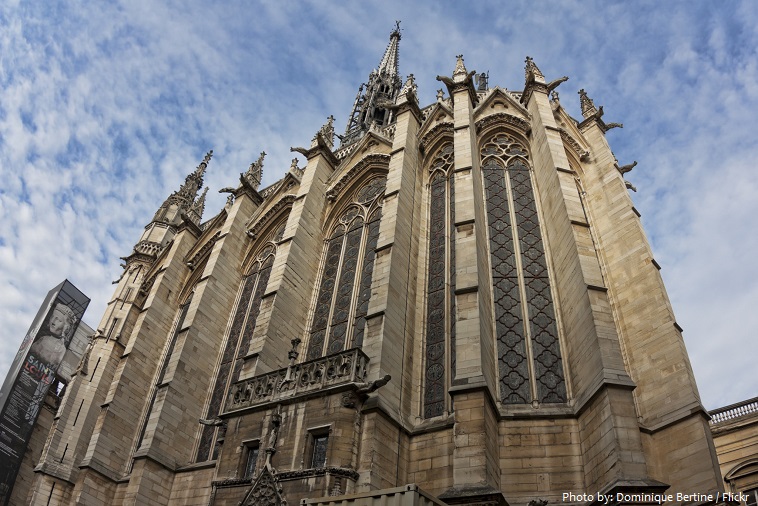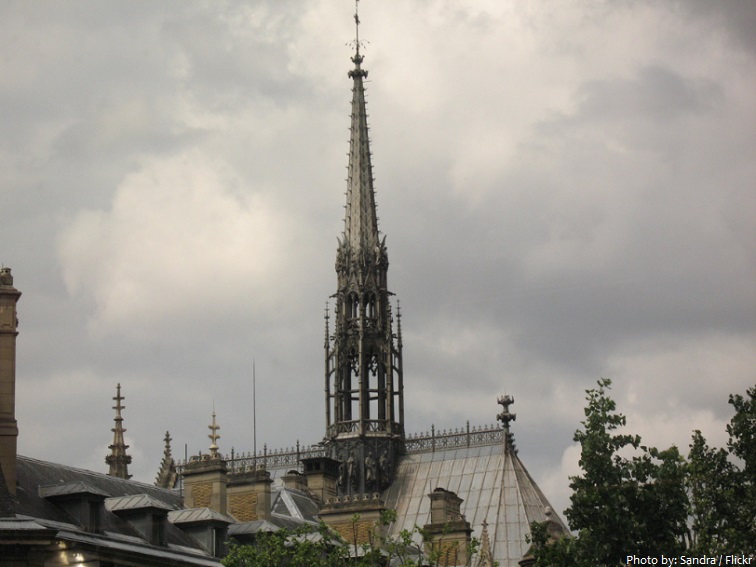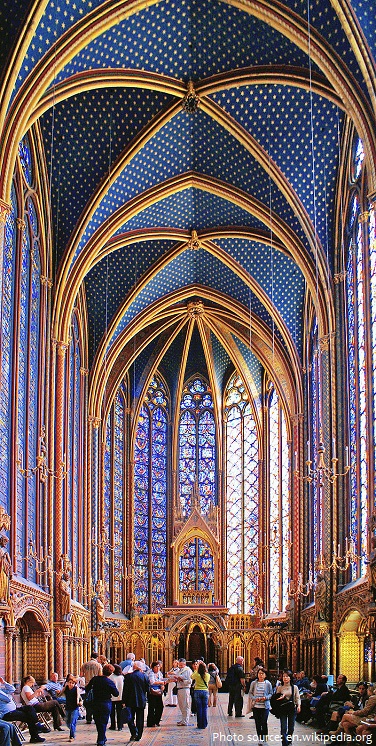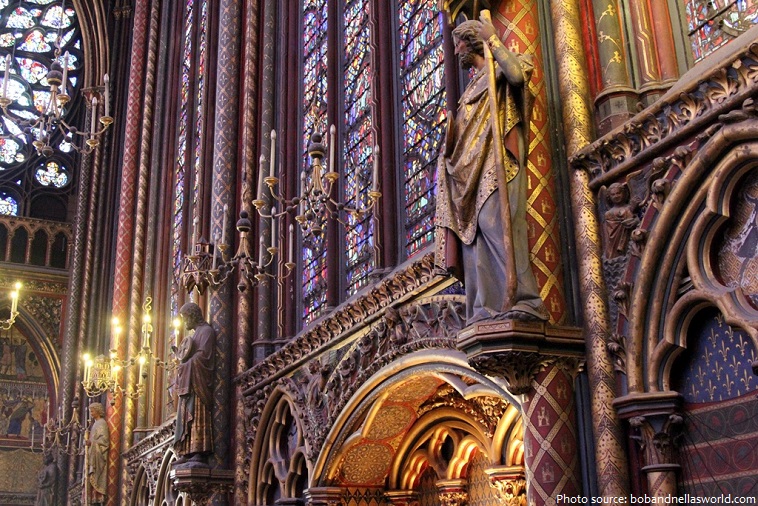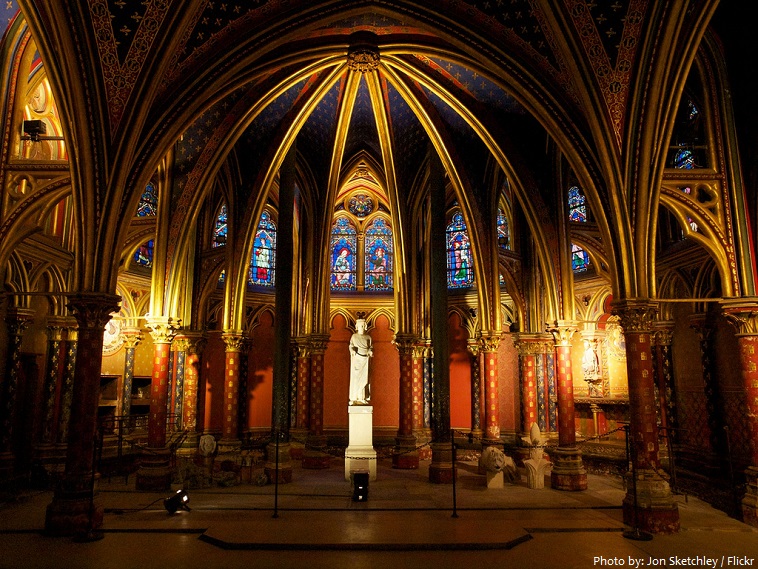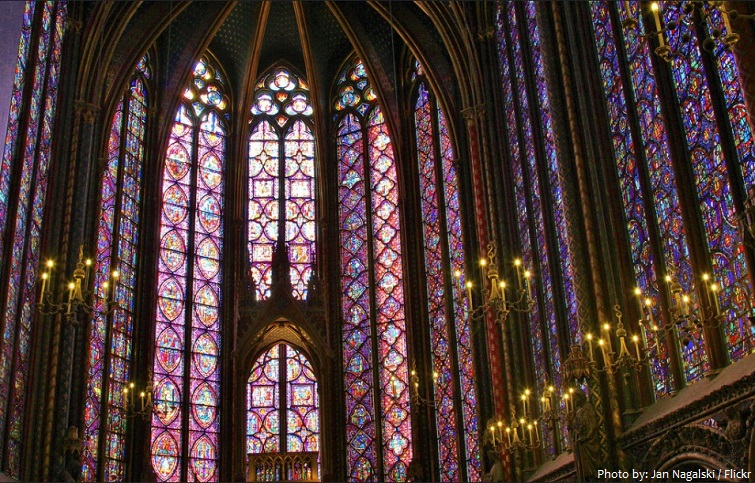The Sainte-Chapelle (“Holy Chapel”) is a royal chapel in the Gothic style located within the Palais de Justice complex on the Ile de la Cité n the center of Paris, France.
Sainte-Chapelle was founded by King Louis IX of France, who constructed it as a chapel for the royal palace and to house Passion relics including Christ’s Crown of Thorns — one of the most important relics in medieval Christendom.
Begun some time after 1238 and consecrated on 26 April 1248, the Sainte-Chapelle is considered among the highest achievements of the Rayonnant period of Gothic architecture.
The structure is 36 meters (118 feet) long, 17 meters (56 feet) wide, and 42.5 meters (139 feet) high.
The chapel exterior shows many of the typical characteristics of Rayonnant architecture—deep buttresses surmounted by pinnacles, crocketted gables around the roof-line and vast windows subdivided by bar tracery.
The slate roof is dominated by the spire made of cedar, 33 meters (108 feet) high, a masterpiece of finesse, made in the 19th century, but an exact replica of the 15th century spire.
The internal division into upper and lower chapels is clearly marked on the outside by a string-course, the lower walls pierced by smaller windows with a distinctive spherical triangle shape.
Although the interior is dominated by the stained glass, every inch of the remaining wall surface and the vault was also richly colored and decorated.
The upper chapel is resplendent in its Gothic architecture – light, color, and space blend to inspire a sense of harmony between art and religious faith. Architects, sculptors and painters evidently took the greatest care with the interior of the upper chapel, as this was the part of the building reserved for the king, his close friends and family, as well as for displaying the religious relics.
Above the lower part of a wall level, mounted on the clustered shafts that separate the great windows, are 12 larger-than-life-sized sculpted stone figures representing the 12 Apostles (six of these are replicas—the damaged originals are now in the Musée du Moyen Age).
The lower chapel is dedicated to the Virgin Mary, whose statue stands freely next to the central pier of the portal. Low vaulted ceilings rest on fine columns with crocketed capitals, linked by anchor braces made of wood or stone. The walls are decorated with trefoiled arcades and twelve medallions representing the Apostles.
The most famous features of the chapel, among the finest of their type in the world, are the great stained glass windows, for whose benefit the stone wall surface is reduced to little more than a delicate framework. Fifteen huge mid-13th-century windows fill the nave and apse, while a large rose window with Flamboyant tracery (added to the upper chapel c. 1490) dominates the western wall.
Although damaged during the French Revolution, and restored in the 19th century, it has one of the most extensive 13th-century stained glass collection anywhere in the world.
The 600 square meters (6,456 square feet) of stained glass windows in the upper chapel illustrate biblical scenes from both testaments. Overwhelmingly deep red and blue, they depict 1,130 biblical figures.
As well as serving as a place of worship, the Sainte-Chapelle played an important role in the political and
cultural ambitions of King Louis to be the central monarch of western Christendom.
At the time Louis’ royal chapel was constructed, the imperial throne at Constantinople was occupied by a mere Count of Flanders and the Holy Roman Empire was in uneasy disarray.
Just as the Emperor could pass privately from his palace into the Hagia Sophia in Constantinople, so now Louis could pass directly from his palace into the Sainte-Chapelle. More importantly, the two-story palace chapel had obvious similarities to Charlemagne’s palatine chapel at Aachen (built 792–805) — a parallel that Louis was keen to exploit in presenting himself as a worthy successor to the first Holy Roman Emperor.
Louis IX had purchased Passion relics in 1239 from the Byzantine emperor Baldwin II, for the exorbitant sum of 135,000 livres (the chapel “only” cost 40,000 livres to build).
The king was later recognized as a saint by the Catholic Church. His title became Saint Louis.
The Sainte-Chapelle has been a national historic monument since 1862.
The chapel, which now attracts more than 900,000 visitors a year, was visited by Adolf Hitler in June 1940 during his only trip to the French capital.
The Sainte-Chapelle has been under restoration since the late 1970s. Air pollution, the elements and the large number of visitors were causing damage to the stained glass windows.

